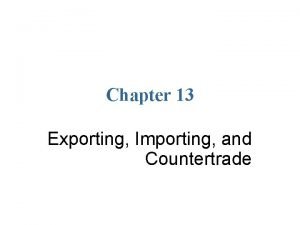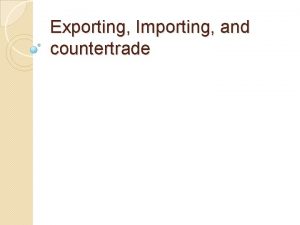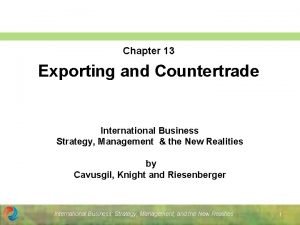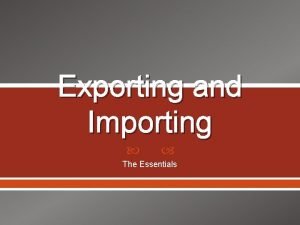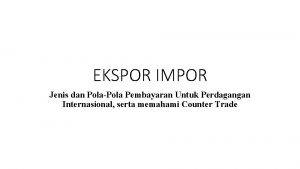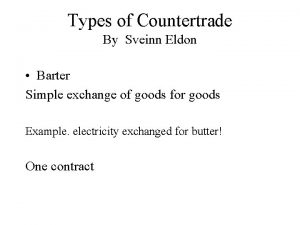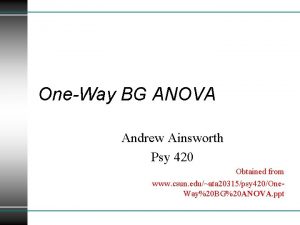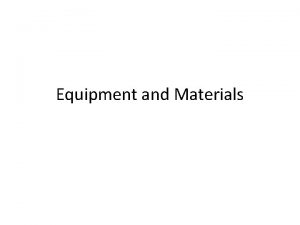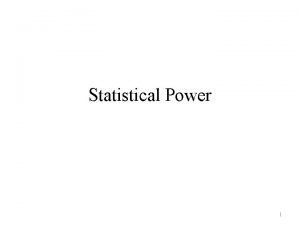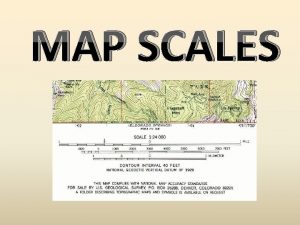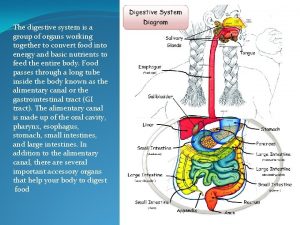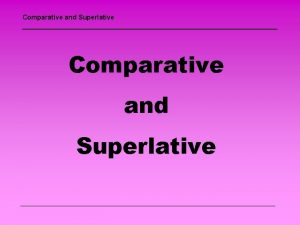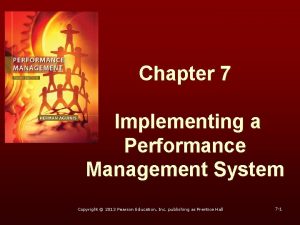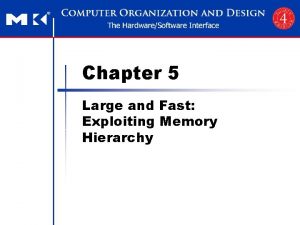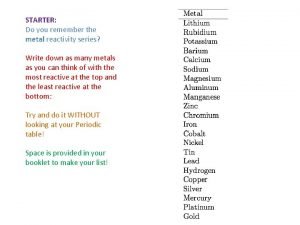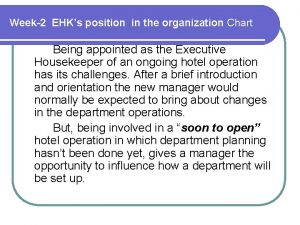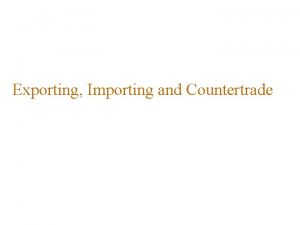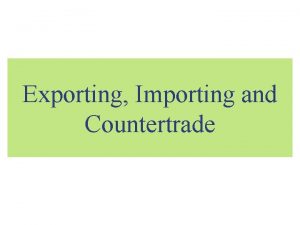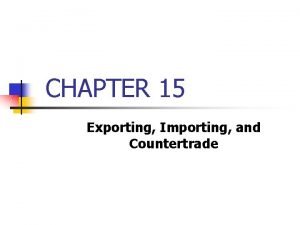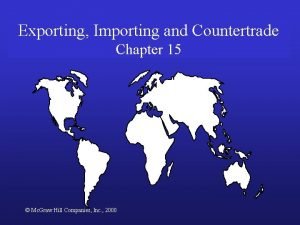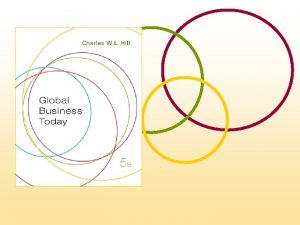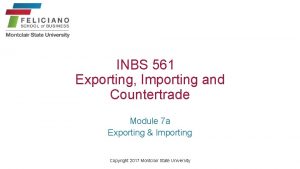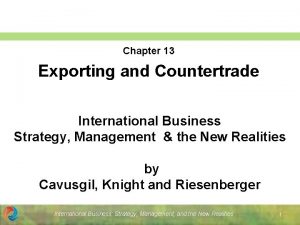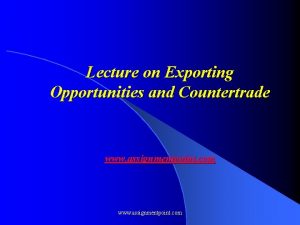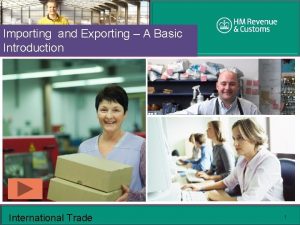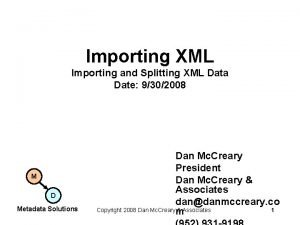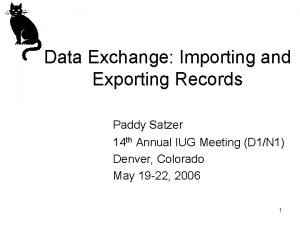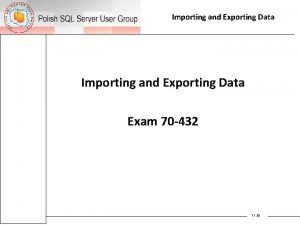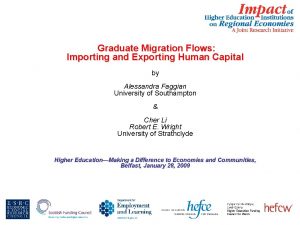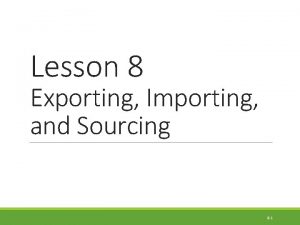Exporting Importing and Countertrade Introduction Large and small










































- Slides: 42

Exporting, Importing and Countertrade

Introduction Large and small firms export Exporting is on the rise thanks to the decline in trade barriers under the WTO and regional economic agreements such as the EU and NAFTA Exporting firms need to identify market opportunities deal with foreign exchange risk navigate import and export financing understand the challenges of doing business in a foreign market 15 -2

Introduction • Firms that do not export lose out on huge opportunities for growth and cost reduction. • Large firms tend to be pro-active in seeking foreign opportunities, while medium and small-sized firms are slow to respond. • Too busy with local side of business • Ignorant of potential opportunities • Intimidated by mechanics of exporting to a foreign country 15 -3

The Promise And Pitfalls Of Exporting is a way to increase market size--the rest of the world is usually much larger market than the domestic market Large firms often proactively seek new export opportunities Many smaller firms are reactive and wait for the world to come to them Many firms fail to realize the potential of the export market Smaller firms are often intimidated by the complexities of exporting and initially run into problems 15 -4

The Promise And Pitfalls Of Exporting Common pitfalls include: poor market analysis poor understanding of competitive conditions a lack of customization for local markets a poor distribution program poorly executed promotional campaigns problems securing financing a general underestimation of the differences and expertise required foreign market penetration an underestimation of the amount of paperwork and formalities involved 15 -5

Improving Export Performance There are various ways to gain information about foreign market opportunities and avoid the pitfalls associated with exporting Some countries provide direct assistance to exporters Export management companies can also help with the export process 15 -6

An International Comparison A big impediment to exporting is the simple lack of knowledge of the opportunities available To overcome ignorance firms need to collect information Both Germany and Japan have developed extensive institutional structures for promoting exports Japanese exporters can also take advantage of the knowledge and contacts of sogo shosha, the country’s great trading houses In contrast, American firms have far fewer resources available 15 -7

Information Sources The U. S. Department of Commerce is the most comprehensive source of export information for U. S. firms The International Trade Administration and the United States and Foreign Commercial Service Agency can provide “best prospects” lists for firms The Department of Commerce also organizes various trade events to help firms make foreign contacts and explore export opportunities The Small Business Administration is also a source of assistance Local and state governments can also provide export support 15 -8

Utilizing Export Management Companies Export management companies (EMCs) are export specialists that act as the export marketing department or international department for client firms EMCs normally accept two types of export assignments: they start exporting operations for a firm with the understanding that the firm will take over operations after they are well established they start services with the understanding that the EMC will have continuing responsibility for selling the firm’s products 15 -9

Utilizing Export Management Companies A good EMCs will help the neophyte exporter identify opportunities and avoid common pitfalls However, not all EMCs are equal —some do a better job than others Firms that rely on an EMC may not develop their own export capabilities 15 -10

Export Strategy To reduce the risks of exporting, firms should hire an EMC or export consultant, to help identify opportunities and navigate through the tangled web of paperwork and regulations so often involved in exporting focus on one, or a few, markets at first enter a foreign market on a fairly small scale in order to reduce the costs of any subsequent failures recognize the time and managerial commitment involved develop a good relationship with local distributors and customers hire locals to help establish a presence in the market be proactive 15 -11 consider local production

Export And Import Financing Over time, various mechanisms for financing exports and imports have evolved in response to a problem that can be particularly acute in international trade: the lack of trust that exists when one must put faith in a stranger 15 -12

Lack Of Trust Many international transactions are facilitated by a third party (normally a reputable bank) By including the third party, an element of trust is added to the relationship 15 -13

Lack Of Trust 15 -14

15 -15 Tools used to aid transactions Letters of Credit (LOC) Drafts (Bill of Exchange) Bank guarantee on behalf of importer to exporter assuring payment when exporter presents specified documents Written order exporter, telling an importer to pay a specified amount of money at a specified time Bill of Lading Issued to exporter, by carrier. Serves as receipt, contract and document of title 15 -15

Letter Of Credit A letter of credit is issued by a bank at the request of an importer and states the bank will pay a specified sum of money to a beneficiary, normally the exporter, on presentation of particular, specified documents The main advantage of the letter of credit is that both parties to the transaction are likely to trust a reputable bank even if they do not trust each other 15 -16

Draft A draft, also called a bill of exchange, is the instrument normally used in international commerce for payment A draft is simply an order written by an exporter instructing an importer, or an importer's agent, to pay a specified amount of money at a specified time A sight draft is payable on presentation to the drawee while a time draft allows for a delay in payment - normally 30, 60, 90, or 120 days 15 -17

Bill Of Lading The bill of lading is issued to the exporter by the common carrier transporting the merchandise It serves three purposes: it is a receipt it is a contract it is a document of title 15 -18

15 -19 Preference of the US exporter 15 -19

15 -20 Preference of the French importer 15 -20

15 -21 The use of a third party 15 -21

A Typical International Trade Transaction 15 -22

Export Assistance There are two forms of government-backed assistance available to exporters: 1. Financing aid is available from the Export. Import Bank 2. Export credit insurance is available from the Foreign Credit Insurance Association 15 -23

Government Assistance in Exporting For political reasons (having to do with mercantilism), most developed countries offer competitive assistance to domestic exporters. This assistance often takes the form of subsidized credit that can be extended to exporters. Also credit insurance programs that guarantee financing extended by private financial institutions are common. Mc. Graw-Hill/Irwin 15 -24 Copyright © 2001 by The Mc. Graw-Hill Companies, Inc. All

Export-Import Bank The Export-Import Bank (Eximbank) is an independent agency of the U. S. government It provides financing aid to facilitate exports, imports, and the exchange of commodities between the U. S. and other countries Exim-bank achieves its goals though various loan and loan guarantee programs 15 -25

The Export-Import Bank and Affiliated Organizations In 1934 the Exim bank of the United States was founded as an independent government agency to facilitate and finance U. S. export trade. Exim bank’s purpose is to provide financing in situations where private financial institutions are unable or unwilling to because: 1. 2. 3. 4. The loan maturity is too long. The amount of the loan is too large. The loan risk is too great. The importing firm has difficulty in obtaining hard currency. Mc. Graw-Hill/Irwin 15 -26 Copyright © 2001 by The Mc. Graw-Hill Companies, Inc. All

Export Credit Insurance Export credit insurance protects exporters against the risk that the importer will default on payment In the U. S. , export credit insurance is provided by the Foreign Credit Insurance Association (FICA) FICA provides coverage against commercial risks and political risks 15 -27

Countertrade When conventional means of payment are difficult, costly, or nonexistent, some firms may turn to countertrade Countertrade refers to a range of barterlike agreements that facilitate the trade of goods and services for other goods and services when they cannot be traded for money 15 -28

Counter-trade Countertrade is an umbrella term used to describe many different types of transactions each in “which the seller provides a buyer with goods or services and promises in return to purchase goods or services from the buyer”. Countertrade may or may not involve the use of currency, as in barter. Mc. Graw-Hill/Irwin 15 -29 Copyright © 2001 by The Mc. Graw-Hill Companies, Inc. All

Forms of Countertrade Barter A clearinghouse arrangement is a form of barter in which the traders agree to buy a certain amount of goods from each other. The direct exchange of goods between traders. Barter requires a double coincidence of wants. They set up accounts with each other that are debited and credited as needed. At the maturity of the arrangement, the parties settle up in cash or merchandise. A switch trade is the purchase by a third party of one country’s clearing agreement balance for hard currency. Mc. Graw-Hill/Irwin 15 -30 Copyright © 2001 by The Mc. Graw-Hill Companies, Inc. All

Advantages of Countertrade conserves cash and hard currency Advantages also include the improvement of trade imbalances, the maintenance of export prices, enhanced economic development, increased employment, technology transfer, market expansion, increased profitability, less costly sourcing of supply reduction of surplus goods from inventory, and the development of marketing expertise. 15 -31

Disadvantages of Countertrade It is inefficient. Some claim that such transactions tamper with the fundamental operation of free markets, and therefore resources will be used inefficiently. Transactions that do not make use of money represent a huge step backwards in economic development. Mc. Graw-Hill/Irwin 15 -32 Copyright © 2001 by The Mc. Graw-Hill Companies, Inc. All

Generalizations about Countertrade There advantages and disadvantages associated with countertrade. It can benefit both parties and in some circumstances is the only trade possible. Whether countertrade transactions are good or bad for the global economy, it appears certain that they will increase in the near future as world trade increases. Mc. Graw-Hill/Irwin 15 -33 Copyright © 2001 by The Mc. Graw-Hill Companies, Inc. All

The Incidence Of Countertrade During the 1960 s, when the Soviet Union and the Communist states of Eastern Europe had nonconvertible currencies, countertrade emerged as a means purchasing imports During the 1980 s, the technique grew in popularity among many developing nations that lacked the foreign exchange reserves required to purchase necessary imports There was a notable increase in the volume of countertrade after the Asian financial crisis of 1997 15 -34

The Incidence or Types Of Countertrade There are five distinct versions of countertrade: 1. barter 2. counterpurchase 3. offset 4. compensation or buyback 5. switch trading 15 -35

The types Of Countertrade 1. Barter is a direct exchange of goods and/or services between two parties without a cash transaction Barter is the most restrictive countertrade arrangement It is used primarily for one-time-only deals in transactions with trading partners who are not creditworthy or trustworthy 2. Counter purchase is a reciprocal buying agreement It occurs when a firm agrees to purchase a certain amount of materials back from a country to which a sale is made 15 -36

The types Of Countertrade 3. Offset is similar to counterpurchase insofar as one party agrees to purchase goods and services with a specified percentage of the proceeds from the original sale The difference is that this party can fulfill the obligation with any firm in the country to which the sale is being made 4. A buyback occurs when a firm builds a plant in a country —or supplies technology, equipment, training, or other services to the country—and agrees to take a certain percentage of the plant’s output as a partial payment for the contract 15 -37

The types Of Countertrade 5. Switch trading refers to the use of a specialized thirdparty trading house in a countertrade arrangement When a firm enters a counterpurchase or offset agreement with a country, it often ends up with what are called counterpurchase credits, which can be used to purchase goods from that country Switch trading occurs when a third-party trading house buys the firm’s counterpurchase credits and sells them to another firm that can better use them 15 -38

Pros of Countertrade Gives firm a way to finance an export deal when other means are unavailable Importer’s government may require it Most attractive to large, diverse multinational firms which can use it as a strategic marketing tool 15 -39

Cons of Countertrade Firms prefer hard currency payments May involve defective or poor-quality goods Must develop in-house trading department Usually expensive and time consuming Not attractive to small and medium sized firms 15 -40

The Pros And Cons Of Countertrade is attractive because it gives a firm a way to finance an export deal when other means are not available If a firm is unwilling to enter a countertrade agreement, it may lose an export opportunity to a competitor that is willing to make a countertrade agreement In some cases, a countertrade arrangement may be required by the government of a country to which a firm is exporting goods or services 15 -41

The Pros And Cons Of Countertrade is unattractive because it may involve the exchange of unusable or poor-quality goods that the firm cannot dispose of profitably It requires the firm to establish an in-house trading department to handle countertrade deals Countertrade is most attractive to large, diverse multinational enterprises that can use their worldwide network of contacts to dispose of goods acquired in countertrade deals 15 -42
 Offset counter trade
Offset counter trade The great promise of exporting is that
The great promise of exporting is that Exporting importing and sourcing
Exporting importing and sourcing Direct exporting
Direct exporting Why did britain begin exporting opium to china?
Why did britain begin exporting opium to china? Exporting office essentials
Exporting office essentials Countertrade adalah
Countertrade adalah Switch trading countertrade
Switch trading countertrade A drawback of countertrade is that
A drawback of countertrade is that Types of counter trade
Types of counter trade A large heavy truck and a small baby carriage
A large heavy truck and a small baby carriage Effect size omega squared
Effect size omega squared Small intestine
Small intestine Tattooing instruments — small and large
Tattooing instruments — small and large Line scale geography
Line scale geography Effect size f small, medium large
Effect size f small, medium large Cohen's d
Cohen's d Effect size small medium large
Effect size small medium large Our cosmic address
Our cosmic address What is statement scale?
What is statement scale? Large scale vs small scale map
Large scale vs small scale map Introduction to topographic maps
Introduction to topographic maps Large scale vs small scale map
Large scale vs small scale map Scientific notation rules
Scientific notation rules Valvulae conniventes vs haustra
Valvulae conniventes vs haustra Esophagus stomach small intestine large intestine
Esophagus stomach small intestine large intestine Small basic code
Small basic code Intro paragraph layout
Intro paragraph layout Large comparative and superlative
Large comparative and superlative Well comparative
Well comparative Comparative of superiority comfortable
Comparative of superiority comfortable Superlative good
Superlative good By and large what is the cause of intentional rating errors
By and large what is the cause of intentional rating errors Large and fast: exploiting memory hierarchy
Large and fast: exploiting memory hierarchy Large rectangular pan, often with a lid and a meat rack.
Large rectangular pan, often with a lid and a meat rack. A large truck and a volkswagen have a head-on collision
A large truck and a volkswagen have a head-on collision In 479 b.c., a large and unified greek army
In 479 b.c., a large and unified greek army How to memorize metal reactivity series
How to memorize metal reactivity series Woodcutter once upon a time
Woodcutter once upon a time I look like a nail but i am a bud
I look like a nail but i am a bud Starbucks brand elements
Starbucks brand elements Organization chart of large hotel
Organization chart of large hotel 3 degree of comparison
3 degree of comparison
